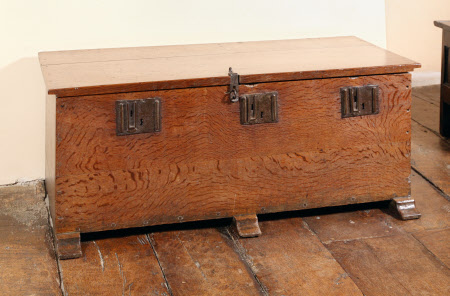Boarded chest
Category
Furniture
Date
circa 1570
Materials
Oak, iron
Measurements
59 x 143 x 66 cm
Place of origin
England
Order this imageCollection
Sizergh Castle, Cumbria
NT 997995
Summary
A boarded oak chest, English, probably made in Westmorland, circa 1570. The top, bottom, sides, front and rear constructed from two boards, all approximately 1in thick. The front, sides and rear boards joined by a rebate joint fixed with squared wooden pegs. The top lacking pegged side bearers (there is a channel to the underside of the top at each side edge, and old peg sites). The top fitted with three nailed iron strap hinges, which taper slightly along their length and have flared terminals. The hinges are set into the outside of the upper rear board, and are set into the underside of the lid, so that they sit flush with the boards. The top is fitted with an iron loop which is fitted with a simple iron hasp. The hasp is angled and fits into another iron loop hammered into the front of the chest, to the right of the lockplate, for a padlock. The front applied with three iron lockplates, secured by plain iron buttresses, and with a hasp guard. All three keyholes backing onto timber. The hasp for the central lock remains – it is lacking to the other two, although there is wear to the underside of the front edge of the top above both of the outer locks suggesting that hasps were once fitted for them. It has been said that the padlock loop to this chest might be later, but the fact that all three locks back directly onto timber – i.e. a key won’t fit into the keyhole – suggests that the padlock loop may be original. The locks have probably been modified. The interior of the chest fitted with a lidded till at its left proper end. The boards which form the till hung on grooves in the front and rear boards. The whole is raised on three shaped sledge type supports with shaped feet.
Full description
Of English construction for this period, with boards secured by squared pegs, and with inset strap hinges, both features thought to be typical of mid-sixteenth century English chests. Probably made by English craftsmen. Related to three other chests at Sizergh [NT 998159.1 – 3] – it is constructed in exactly the same way, although lacks their decorative lockplate surrounds – and was almost certainly made by the same person or workshop. An inventory taken in 1569 records ‘iii chests’ ‘in the lords chamber’, as well as single examples in other rooms. (Megan Wheeler, 2016)
Provenance
Probably purchased by Walter and/or Agnes Strickland, circa 1570. Thence by descent, and given by Henry Hornyold Strickland (1890 – 1975) with Sizergh Castle and its estates in 1950.
